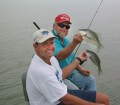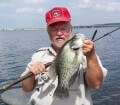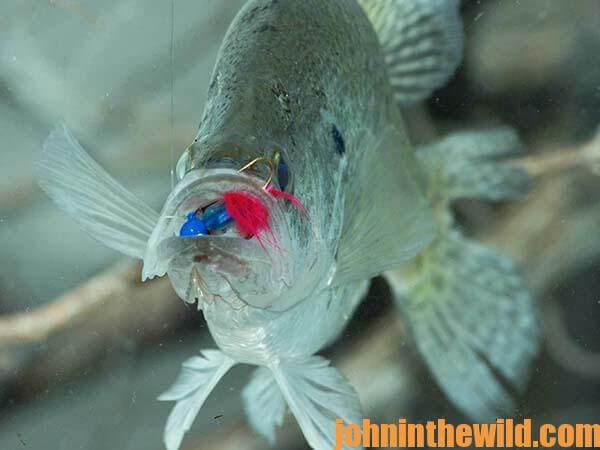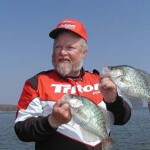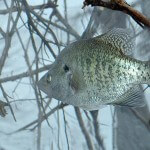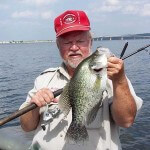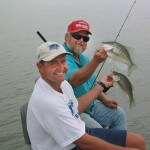John’s Note: 2014 is Steve McCadams’ 40th year of guiding crappie fishermen on Kentucky Lake. He also fished crappie tournaments for 10 years, and at one time he was part owner of Crappie USA. “I guess you could call me a crappie farmer, because I put out a lot of crappie cover and harvest a lot of crappie,” McCadams says. Except when he’s guiding or hunting ducks, McCadams guides crappie fishermen and catches crappie every day of the year. The secret for finding and catching crappie is to know where the crappie live and build homes for crappie. “I guide for crappie 9-10 months out of the year on Kentucky Lake, and we’ve never struck out,” McCadams reports. He only may catch 1-10 crappie, when he’s fishing an hour or two on the lake, because of high winds, snow, thunder or lightning. With two clients in the boat, McCadams averages keeping 40-45 crappie per day. On Kentucky Lake where he primarily fishes, anglers only can keep crappie 10-inches long or longer. However, on an average day, his clients may catch 100 crappie and release the undersized ones.
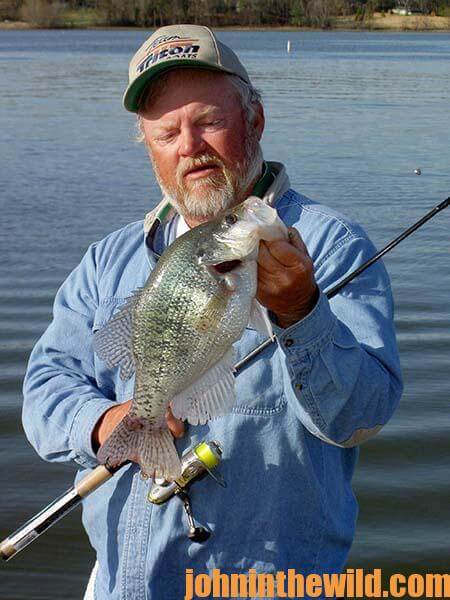 Solving the Problem of Other Crappie Fishermen Fishing My Stake Beds:
Solving the Problem of Other Crappie Fishermen Fishing My Stake Beds:
Usually, I have very-few problems with other crappie fishermen fishing the stake beds I put out. Because as I’d mentioned earlier in the week, I try to keep my stake beds underwater and out of sight. One of the greatest inventions for me has been GPS (global positioning system). In the old days, when I first started guiding, there was no GPS. So, I had to use triangulation, landmarks and my best guesses to find my stake beds. I used those old navigation systems for about 20 to 25 years, before GPS was ever made available to the fishing public. Most of the time back then, even if someone found one of my stake beds, the odds of relocating that stake bed on his next trip to the lake were pretty slim.
But today with GPS, once a person locates a stake bed or a brush shelter, they can punch that location in as a waypoint on their GPS receivers and return to that location anytime they want to fish it. But because I have built so many stake beds, this isn’t nearly as big of a problem for me as it will be for someone who’s only built 1-10 stake beds. Even if another angler does find one of your stake beds and marks it as a waypoint, he or she won’t fish that fish attractor every day of the week. Those stake beds will fill-up with crappie again, even after a good number of crappie have been caught off them.
Fishing the Same Stake Bed: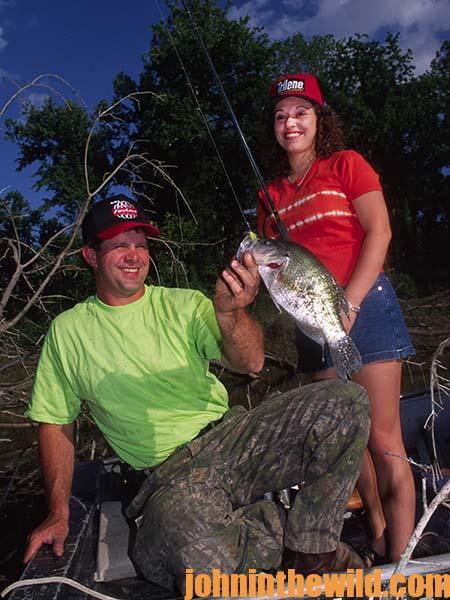
I never fish the same stake beds on 2 consecutive days. I like to try and give my stake beds at least one day of rest before I go back to them. However, if a stake bed is really producing crappie, I may go back to it the next morning – especially during bad weather – if that stake bed has produced good numbers of crappie, and on the following day, if the same wind direction occurs.
In the early spring, when crappie are moving a lot, and in the early fall when you have crappie moving in and out of shallow water, I believe that my brush shelters restock themselves with crappie. For instance, if my party and I have caught all the crappie I think we can catch off one stake bed in the morning, and the weather’s bad, I have gone back to that same stake bed within 2 or 3 hours after I’ve fished it and caught good numbers of crappie that second time I’ve fished that stake bed on the same day. But this is an exception to my usual rule of letting a stake bed rest for a day before I fish it again.
I’ve also learned that in the late fall and winter, crappie don’t move as much. I may need to let my stake beds rest longer before I return to fish them. However, when really-cold weather is present, and then a warm front comes through, crappie usually will move during the warm front. So, for every rule that I’ve developed about fishing brush shelters, there are exceptions.
 Fishing Vertical Structures like Stake Beds Instead of Brush Piles and Tree Tops:
Fishing Vertical Structures like Stake Beds Instead of Brush Piles and Tree Tops:
I like stake beds and vertical-type structure for shallow-water and mid-depth brush shelters. In water depths of 15 feet or less, I prefer stake beds, because you can fish them fairly easily without your hook getting hung, especially if you’re paying close attention to your line.
Another secret of successful single-pole fishing is you don’t ever want your line to drag. You want that minnow to go straight down and come straight back up. By fishing like this, you won’t get hung-up nearly as much as anglers who drag their lines. You want that line to come straight down out of the tip of your pole. If you see your line at an angle from your pole, the line is telling you that you’re dragging the line. More than likely, you’ll get hung-up in the underwater brush. In a day of fishing, you’ll have much fewer hang-ups than you will, if you’re fishing a treetop or a fish attractor that’s made out of brush.
When I’m fishing in deep water, I’ll usually fish with a double-minnow rig on a single pole or a rod. Even then, we want to keep that line straight up and down from the rod or pole tip. Having said this, when you go crappie fishing, if you’re not getting hung, you won’t catch any fish. You’ll lose a few hooks and/or a few jigs. However, if your line is straight down out of the tip of your pole or rod, you’ll lose fewer hooks and fewer jigs.
Usually, I spend the first hour of a guide trip teaching crappie fisherman when NOT to jerk, pull and try to set the hook. To have the most-successful day of crappie fishing that you can have, learning when NOT to set the hook is just as important as knowing when to set the hook. Most of the time, you can get your hooks out of cover, if you just let your line down and jiggle it a little bit, if you don’t set the hook hard. However, if you make a hard hook set in thick cover or even in a stake bed, you’ll probably have to break your line. An angler may lose four or five jigs or hooks in a day. Usually, within an hour or two, I can teach a novice crappie fisherman how to watch his line and how to determine the difference between a crappie taking its bait or the bait hitting the structure.
To learn much more about crappie fishing, get John E. Phillips’ Kindle eBooks and some print books, “Crappie: How to Catch Them Fall & Winter,” “Crappie: How to Catch Them Spring and Summer,” “Catch Cold Water Crappie Now,” and “Reelfoot Lake: How to Fish for Crappie, Bass, Bluegills and Catfish & Hunt for Ducks.” Click here to get these books.
Steve McCadams Professional Guide Service – stevemc@charter.net – (731) 642-0360
Share this page with a friend!
About the Author
John Phillips, winner of the 2012 Homer Circle Fishing Award for outstanding fishing writer by the American Sportfishing Association (ASA) and the Professional Outdoor Media Association (POMA), the 2008 Crossbow Communicator of the year and the 2007 Legendary Communicator chosen for induction into the National Fresh Water Hall of Fame, is a freelance writer (over 6,000 magazine articles for about 100 magazines and several thousand newspaper columns published), magazine editor, photographer for print media as well as industry catalogues (over 25,000 photos published), lecturer, outdoor consultant, marketing consultant, book author and daily internet content provider with an overview of the outdoors.

